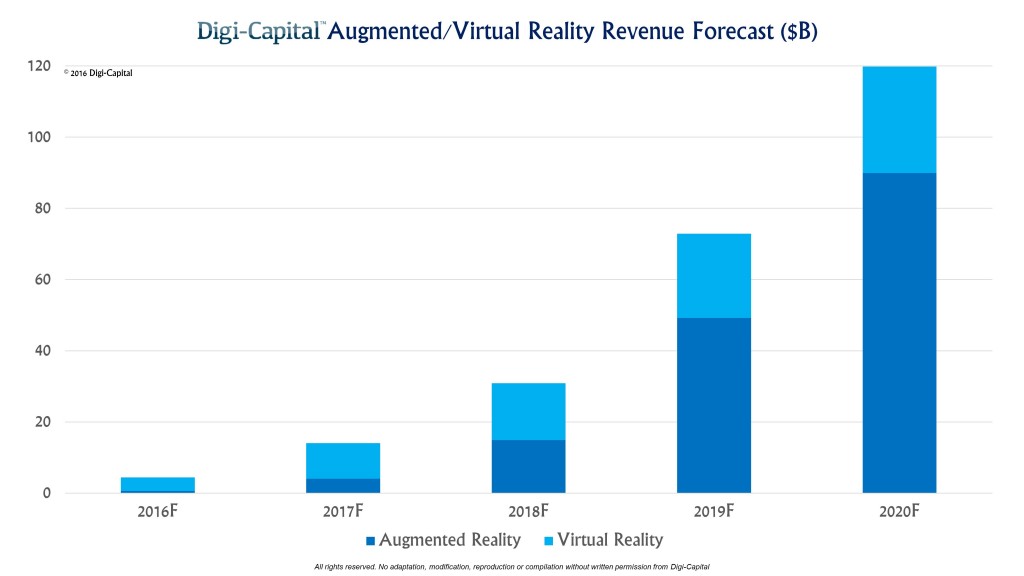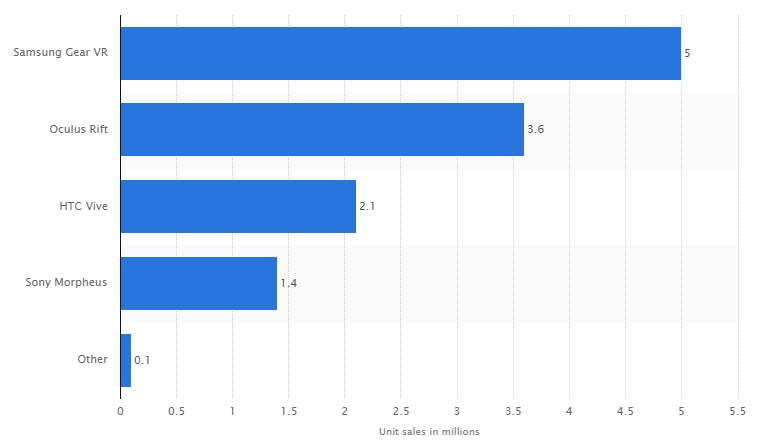Emerging Trends in VR and AR for 2017 – WebVR Becomes the Best Play
Techcrunch has a good article on the difference between VR/AR hype a year ago and information from the first year of consumer tech. What emerges is a surprise.
https://techcrunch.com/2017/01/11/the-reality-of-vrar-growth/
If you’ve followed this area, the original prediction for VR was rapid growth to a relatively small market share, with AR (Augmented Reality) starting slow but ultimately becoming 5-10 times larger than VR. Many predictions also assumed that VR would finally take off when it was integrated with home entertainment centers, similar to games. The market was assumed overall to be > $100 billion in a few years:
Originally, forecasts assumed that custom headsets like the Oculus Rift would dominate. By the 2016 forecast above, people had begun to realize that mobile devices provided a great, low-cost entry into the VR and AR world, and had upped their estimates for low-end “Google Cardboard” VR experiences.
The actual results, in terms of wins and losses, turn VR and AR more to mobile, location-based services. Headsets did less well than expected. Part of the problem was price – the Oculus Rift was touted as being cheaper than the HTC Vive, but didn’t ship with controllers. When the controllers were added, they both end up costing around $800, which greatly reduced the market. The winner was Samsung Gear VR, which doesn’t have controllers, but leveraged an existing mobile device. Dedicated consoles (e.g. Playstation VR) weren’t a factor in 2016, despite the hype.
Source: https://www.statista.com/statistics/458037/virtual-reality-headsets-unit-sales-worldwide/
These numbers are actually about twice as large as has been reported more recently – in other words, headset sales were only 50% of original expectations. GearVR sales were probably closer to 2 million. Current sales from several sources put the actual sales of the other headsets closer to 1 million each. Originally, Playstation VR was expected to outsell Rift and Vive by a wide margin, but in estimates have been revised downward significantly, to a volume comparable to the Rift and Vive. In 2017, groups look in hope to Windows 10 VR headsets to help lift the market. Also, the massive investment in the cryptic Magic Leap might begin to show results (but don’t count on it).
In contrast, location-based Augmented Reality in a regular phone “app” model drive the market, mostly through the breakout hit Pokemon Go. This game was the first contact a significant part of the public had with the VR/AR hype. The reason? You could use the phone you have to play, and development used standard technologies instead of custom SDKs or frameworks. And AR didn’t need additional headsets or “spectacles” for its use. This has caused everyone, from Apple (where are you?) to Facebook to proclaim that AR is the near-term thing. And certainly, there’s a play there.
What do lower expectations for high-end headsets mean for VR and AR in the next year? Content creators will need to leverage existing technology, and develop for the low end. Smartphones will get better in 2017, and increasingly they will natively support AR and VR, along with “3D imaging” – determining depth in images. It’s easy to see how this will integrate in a few years. But not just yet, since consumers typically take 3 years to replace their devices.
This in turn makes the case for WebVR as a development environment. This year mobile Chrome and Firefox will run VR natively, which will combine with their support for AR via the Geolocation and Media API. So, it is possible to develop VR, AR, and hybrid systems with relatively low-cost strategies using standard web development via HTML, CSS, and JavaScript. A WebVR “web app” can be deployed directly to the Google Cardboard world, and can also serve as a prototype for faster natively-coded systems. Since WebVR supports Vive and Oculus headsets, you’re covered there as well.
http://uploadvr.com/3-reasons-webvr-future-virtual-reality/
And if you’re a web developer who didin’t get into the app world, this is a great opportunity. Native VR and AR is stalled while consumers upgrade their hardware. In contrast, WebVR will run everywhere right now with standard web dev tools and languages. As Eric Floerzano says in his Medium article:
All of a sudden, WebVR is the best channel for small-to-medium sized VR content to be published if it’s intended to go viral and be shared with the most VR users.
Eric also points out the advantages of WebVR (opposed to native, Unity or Unreal Engine) if you find you’re earlier in the VR/AR game than was predicted in 2016:
- Development cycles are faster with WebVR than with native or compile to native (like Unity)
- Testing is easier, since you can check an update by refreshing your browser, instead of downloading and installing a new version of the app
- Consumers will get a constantly updated VR/AR experience, since they can also update by refresh, instead of going to their App Store to re-download the software
In addition to his point, consider the following:
- Portals for creating WebVR experiences (e.g. a YouTube for VR) will become common in 2017, allowing an even easier entry
- The tools for creating WebVR experiences will be online, with little to no cost, as opposed to the $$$ for a traditional software development platform
- Simple VR authored via markup like A-Frame will allow more people – especially design and coding students – create VR/AR as part of portfolios
Unless you’re doing a pure AR play aimed at standard smartphone screens, WebVR lets you get skin in the game, and solve the difficult problems of VR/AR interaction and storytelling. Eric sees VR having its comeback moment in 2019-2020. In 2017, WebVR remains your non-brainer entry to leap ahead into the VR and AR world.


